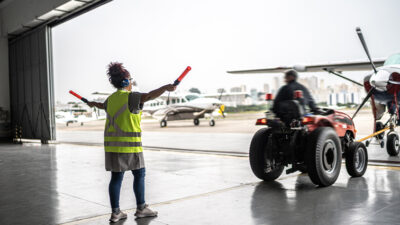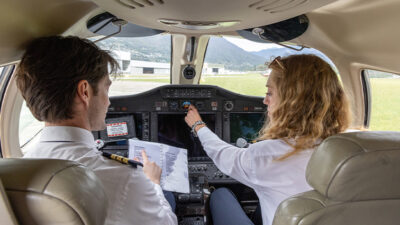Safety Reporting: An Obligation and Opportunity to Contribute to the Greater Good

Safety in aviation is always a top priority. There are many ways to approach this important task, with the first line of defense being a keen and constant personal awareness of one’s habits, health, skill and environment. But even under the best conditions, sometimes there are still various factors that lead to safety incidents or accidents.
As a community, aviation professionals do come together to discuss these experiences and learn through numerous networking symposiums and informational gatherings from organizations dedicated to increasing our proficiency and knowledge—but can we do more?
The Persistent Problem of “Minor” Violations
Fatal accidents naturally grab our attention, and it can often be easy to identify the factors and conditions that contribute to the disastrous outcome as you read through an accident report. However, we know hindsight is always much clearer, so this is only mildly useful in preventing future injuries or deaths.
What we need to remember is that what happens more often than fatalities are the small, seemingly harmless violations that speckle our operating environment and generally go overlooked because, after all, nothing bad happened as a result. Sometimes these small violations even become a habit as they continue to be practiced with no catastrophic consequence.
On March 4, 2019, an Embraer EMB145 attempted to land on a snowy runway at Presque Isle International Airport (PQI) in Maine. Due to weather, fatigue and most notably, a discrepancy with the instrument landing system (ILS), the aircraft impacted a snow-covered grassy area between the runway and the parallel taxiway, severely damaging the aircraft. Luckily, there were no significant injuries to the crew.
One of the more frustrating facts of this incident is pointed out by the National Transportation Safety Board (NTSB) that, “At least six pilots who flew into Presque Isle during the five days before the accident (including the accident’s first officer) encountered issues with the ILS localizer. However, none of those pilots submitted a company aviation safety action program report before the accident.”
Safety Reporting Saves Lives
As much as we like to maintain our reputation and credibility as skilled, exceptional pilots and aviation professionals, there are times when honesty and diligence are not only the best practice, but a selfless practice that may save our aircraft and, quite possibly, the lives of others. Safety reporting is a not only a best practice, but an essential practice that we all must be committed to performing every single time an event occurs.
It’s presumed that the crews in Maine who encountered the same issue of the localizer being out of tolerance by as much as 200 feet to the right did not see this as particularly significant because, for them, the weather was more favorable and visual conditions allowed them to react and correct for the error. But as many will agree, safety reporting requires a bit of self-assessment, courage and scrutiny on the part of everyone involved.
It means having a more holistic approach to our profession and actively looking for things that may cause catastrophic issues for ourselves or those who will come after us. It means employing our own critical thinking, being proactive with safety and adopting the mindset that it is better to report too much than not enough.
Contributing to a Safer Aviation Environment
We all pay close attention to safety bulletins and reports, and often take away valuable lessons for ourselves, but do we each make a concerted effort to contribute to the process and create value of our own? Knowing our weakness is a great start and is deeply important.
For example, it was found in this accident report that fatigue was a contributing issue for the first officer. There was also historical data suggesting the captain had previous issues regarding training and proficiency. All it took was less than desirable weather and a malfunctioning localizer to weave together a significant safety incident.
Being proactive means taking inventory and reporting not only technical and equipment issues, but having ownership of our weaknesses, preparing mitigation strategies and being absolutely committed to our safety reporting culture. In this instance, as with many others, even one safety report could have been the saving grace to avoid disaster for our community.
We appreciate the outcome and want to enjoy the results of safety reporting, but are we willing to do the work in advance to contribute to the end product? Do the work. Hold yourself accountable. Enjoy the spoils. And always, always, be safe.

Advanced Aircrew Academy enables flight operations to fulfill their flight department training needs in the most efficient and affordable way – in any location at any time. We do this by providing high quality professional pilot, flight attendant, flight coordinator, maintenance, and line service modules delivered via the web using a world-class online aviation training system.
https://www.aircrewacademy.com/
© 2024 Advanced Aircrew Academy. All Rights Reserved.
Next ArticleRelated Posts

The Effects of a Learning Mindset on Safety Culture
As aviation departments strive to enhance their safety performance, a critical yet often overlooked element is the need to foster a learning-culture mindset. This mindset shift can unlock invaluable opportunities for continuous improvement, employee engagement and creating a resilient safety environment. From a behavioral management perspective, as your company’s learning culture goes, so goes the ongoing success of your SMS.

Safety in Numbers: Trends in Aviation Accidents and Incidents
Every accident is preventable; the problem is that we don’t know how to prevent it until after the accident happens. However, what we can do as an industry is honor the anguish of each event by sharing the information, the mistakes and the outcomes to improve safety for everyone.
